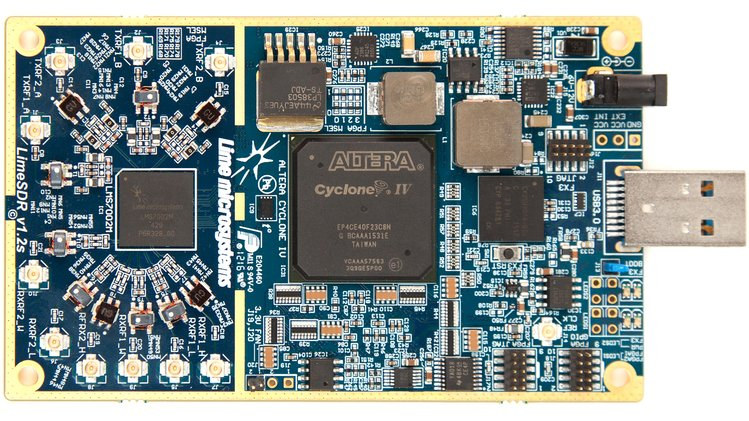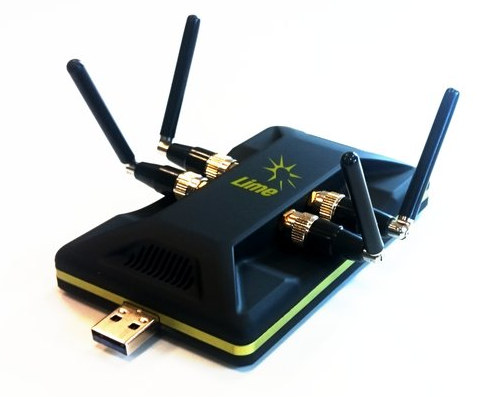Canonical and Lime Micro showcased SoDeRa software defined radio (SDR) a couple of months ago, with a promise to launch a crowdfunding campaign later this year. They’ve fulfill their promise, and launched the open source SDR, renamed to LimeSDR, on Crowdsupply.
 LimeSDR board specifications:
LimeSDR board specifications:
- FPGA – Altera Cyclone IV EP4CE40F23 Altera FPGA compatible with EP4CE30F23
- System Memory – 256 MB DDR2 SDRAM
- RF
- Lime Microsystems LMS7002M RF transceiver with continuous coverage of the frequency range between 100 kHz and 3.8 GHz; 61.44 MHz bandwidth
- 4 x TxOut and 6 x RxIn U.FL connectors
- Power Output (CW): up to 10 dBm
- Wi-Fi, GSM, UMTS, LTE, LoRa, Bluetooth, Zigbee, RFID, Digital Broadcasting, configurable through apps.
- USB – 1x micro USB3 via CYUSB3014-BZXC Cypress Microcontroller for control, data transfer and power
- Misc – Status LEDs, RGB LEDs, 4x switches
- Power – USB or external power supply
- Dimensions – 100 mm x 60 mm
The board interfaces with systems running Snappy Ubuntu Core, and you can enable wireless protocols the easy way by simply installing the required app with snappy. If you implement a new protocol, it can also be easily shared through snappy apps.

Potential applications include radio astronomy,RADAR, 2G to 4G cellular basestation, media streaming (DVB, ATSC, ISDB-T), IoT gateway, HAM radio, wireless keyboard and mice emulation and detection, tyre pressure monitoring systems, aviation transponders, utility meters, drone command and control, test and measurement, and more.
It’s not the first FPGA based SDR system that’s available to hobbyist, so the company compared it to other platform such as HackRF One, BladeRF, and others, include ultra-low cost solution based on RTL-SDR.
| HackRF One | Ettus B200 | Ettus B210 | BladeRF x40 | RTL-SDR | LimeSDR | |
|---|---|---|---|---|---|---|
| Frequency Range | 1MHz-6GHz | 70MHz-6GHz | 70MHz-6GHz | 300MHz-3.8GHz | 22MHz-2.2GHz | 100kHz-3.8GHz |
| RF Bandwidth | 20MHz | 61.44MHz | 61.44MHz | 40MHz | 3.2MHz | 61.44MHz |
| Sample Depth | 8 bits | 12 bits | 12 bits | 12 bits | 8 bits | 12 bits |
| Sample Rate | 20MSPS | 61.44MSPS | 61.44MSPS | 40MSPS | 3.2MSPS | 61.44MSPS (Limited by USB 3.0 data rate) |
| Transmitter Channels | 1 | 1 | 2 | 1 | 0 | 2 |
| Receivers | 1 | 1 | 2 | 1 | 1 | 2 |
| Duplex | Half | Full | Full | Full | N/A | Full |
| Interface | USB 2.0 | USB 3.0 | USB 3.0 | USB 3.0 | USB 2.0 | USB 3.0 |
| Programmable Logic Gates | 64 macrocell CPLD | 75k | 100k | 40k (115k avail) | N/A | 40k |
| Chipset | MAX5864, MAX2837, RFFC5072 | AD9364 | AD9361 | LMS6002M | RTL2832U | LMS7002M |
| Open Source | Full | Schematic, Firmware | Schematic, Firmware | Schematic, Firmware | No | Full |
| Oscillator Precision | +/-20ppm | +/-2ppm | +/-2ppm | +/-1ppm | ? | +/-1ppm initial, +/-4ppm stable |
| Transmit Power | -10dBm+ (15dBm @ 2.4GHz) | 10dBm+ | 10dBm+ | 6dBm | N/A | 0 to 10dBm (depending on frequency) |
| Price | $299 | $686 | $1,119 | $420 ($650) | ~$10 | $299 ($199 early bird) |
As mentioned in the comparison table, LimeSDR is open source hardware and you’ll find the Altium schematics & PCB layout, as well as the manufacturing files in LimeSDR-USB github repo, Altera Quartus FPGA project, Cypress FX3 firmware, source code for the drivers and GUI, and more in the various repo available on myriadrf github account.
So far, the project has raised close to $70,000 out of its $500,000 goal. A $199 early bird pledge should get you LimeSDR board, as long as you are part of the 500 backers (200 left), after which you’d need to pledge $299 for the board. Unless you provide your own antennas, you may want to add $85 to your pledge to get the four antennas and cables, or if you want a complete system with the board, antennas, enclosure, and “turnkey support”, go for the acrylic or aluminum kits for respectively $499 and $599. Shipping is free to the US, and between $15 to $35 to the rest of the world, with delivery scheduled for November or December 2016 depending on the pledge.

Jean-Luc started CNX Software in 2010 as a part-time endeavor, before quitting his job as a software engineering manager, and starting to write daily news, and reviews full time later in 2011.
Support CNX Software! Donate via cryptocurrencies, become a Patron on Patreon, or purchase goods on Amazon or Aliexpress




